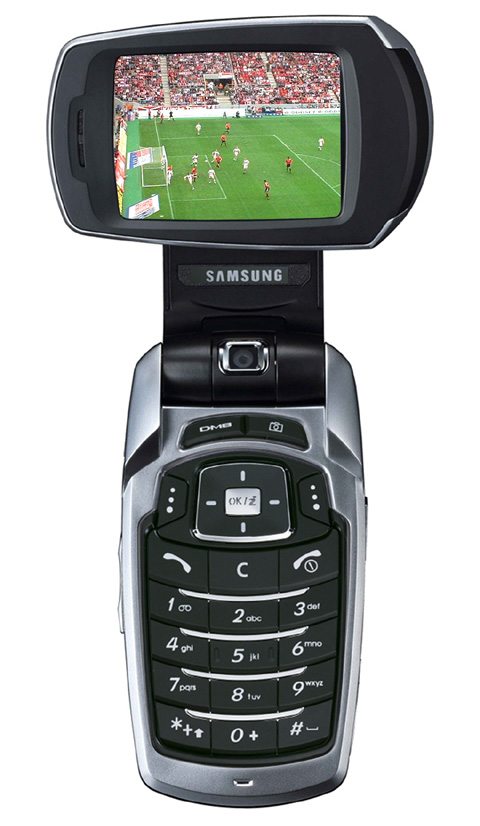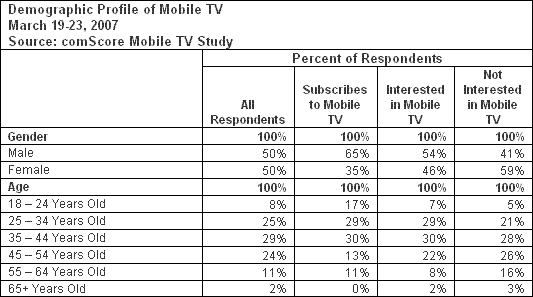Mobile TV: Do We Want It?

What is at the centre of debates about convergent technologies and cultures are questions of how we make use of these new technologies and networks to fashion shared as well as individual spaces in our lives, relationships, and ideas. Thus far, however, the developments surrounding and discourses characterising mobile television have tended to be obscure these developments and struggles in social relations and cultural politics – something that I think merits considered and urgent attention. (Goggin, 2006, p. 186)
In my last column, I raised some questions regarding the place of the conceptual turn to mobility to describe and facilitate understandings of the changing relations of power, the movement of capital and bodies and the ephemeral qualities of digital technologies. I would now like to explicitly address the mobile modification of television, mobile tv.
[youtube]http://youtube.com/watch?v=P2o1iXw3WuQ&feature=related[/youtube]
What do you think of the resolution? When would you watch this? Would you be willing to pay $15 to watch tv programmes on your cell phone? Can your cell phone seamlessly deliver and store tv programmes? Where would you watch the program? Would you wear earphones? How would you feel if you were to hear someone else watching a tv programme near you? Would you consider projecting a tv programme from your mobile onto some kind of screen? Would you want to be able to move tv programmes from one of your digital devices to your mobile phone? Would you walk and watch? Would you talk and watch?
The answers to these questions are still unresolved largely as the result of the long-standing tension in the telecommunication industry’s struggle between content provision and carrier service, interoperability between services and devices, and consumer resistance to its high costs (particularly when individuals can watch television content on traditional sets and on the internet for minimal costs).1
The most recent industry data, IDATE’s mobile tv survey 2008, continues to predict high growth rates in the mobile phone industry (see Table 1) and increased ownership of mobile phones over other telecommunication services (see Figure 1). Moreover, the little empirical data that does exist regarding American uptake of mobile tv has found that its most significant users of mobile tv are young men (Table 3).



Despite industry predictions that mobile tv has significant market potential – it has not done well in North America. I would suggest that the questions I asked earlier have played a role in transitioning citizens, consumers and users from one form of media practice, large screen stationary television viewing, to another mobile, small screen one. Take up has been slow and the limited consumer data we have suggests that the market for this type of service is largely the purview of young men. One could speculate that if young men shape the mobile tv market, largely because of their purchasing power and access to more leisure time, this demographic could limit the kind of programming that may attract other kinds of viewers and consumers. However, I would argue that the kind of empirical data and theorizing that we do have about how North Americans use mobile telephones (World Internet Project, Networked Publics, Katz and Aakhus, 2002; Ling, 2004; Goggin, 2006; Gow and Smith, 2006; Horst and Miller, 2006; Katz, 2006; Castells, et al, 2007) provides us with some insight as to why uptake has been slow and ways that we might want to consider the potential for other media forms emerging from mobile phones.
Many of the cited scholars have engaged with questions about the transition from landline telephones to mobile telephones – how have we taken practices from old media to new ones. This line of inquiry is well articulated by Lev Manovich’s (2001) in The Language of New Media, as he analyzes:
…the language of new media by placing it within the history of modern visual and media cultures. What are the ways in which new media relies on older cultural forms and languages, and what are the ways in which it breaks with them? What is unique about how new media objects create the illusion of reality, address the viewer, and represent space and time [I would add place]? How do conventions and techniques of old media – such as the rectangular frame, mobile viewpoint, and montage – operate in new media? (p.8)
Given that much of our understanding is premised on theorizing the ‘old’ to the ‘new’ – what have we observed about how consumers, users and citizens have taken up in mobile phone practices? One of the most prevalent uses of mobile phones is communication — people like to talk and they are expanding their telephone talk from the confined ‘private’ spaces of home and work to just about anywhere, anytime, any place. So could it be that television viewing outside of the constraints of the household has had a longer public history in sports bars, airports, that as Dowler (2002) has argued the tv has become the ultimate ubiquitous object. My point is that we are asking one device to deliver many media forms and practices — and that may be we need and want more than one device (Middleton, 2007). Moreover, other factors such as non-proprietary software2 have closed interventions and innovations – and ultimately, I would argue development of applications that could make the delivery of tv more user friendly and less costly. However, I do think it is important that we also consider the ways in which consumers, users and citizens have taken up visual communication strategies with their mobile phones in unanticipated ways.
To more explicitly address Goggin’s observations and pleas, there have been a number of interventions and strategies that have circumvented expensive mobile telecommunication costs and that have worked within the confines, constraints and possibilities of mobile phones. Some of these include a series of mobile phone film festivals and artists’ projects. These interventions and strategies have generally taken up the sound and video capacities of mobile phones. Festivals such as Pocket Films, CellFlex, and artists’ projects such as murmur, Antoni Abad’s international projects facilitating community use of mobile phones, and Obx Labs have creatively demonstrated the aesthetic, political, and community potential of the small screen form and interestingly its multi-casting and distribution potential.
Hence, modifying tv with the mobile is not doing well as ‘old’ media practices are not transitioning well to mobile phone platforms — what is more exciting and interesting in terms of the mobile and visual communications have been the ways in which some artists’ projects make demands of and work with what mobile phones can do.
References:
Agar, K. 2003. Constant Touch: A Global History of the Mobile Phone. Cambridge, UK: Icon Books.
Castells, M., M. Fernandez-Ardevol, J. Qiu and A. Sey. 2007. Mobile Communication and Society: A Global Perspective. Boston, MA: MIT Press.
Dowler, K. 2002. “Television and Objecthood: The “place” of Television in Television Studies,” Topia 8: 43-60.
Goggin, G. 2006. Cell Phone Culture, London, UK: Routledge.
Gow, R. and R. Smith. 2006. Mobile and Wireless Communications. Berkshire, UK: Open University Press.
Horst, H. and D. Miller. 2006. The Cell Phone: An Anthropology of Communication. New York, NY: Berg.
Katz, J. and M. Aarkus. (Eds.) 2002. Perpetual Contact: Mobile Communications, Private Talk, Public Performance. Cambridge, UK: Cambridge University Press.
Katz, J. 2006. Magic in the Air: Mobile Communication and the Transformation of Social Life. New Brunswick, NJ: Transaction Publishers.
Ling, R. 2004. The Mobile Connection: Cell Phone’s Impact on Society. San Francisco, CA: Elsevier.
Manovich, L. 2001. The Language of New Media. Boston, MA: MIT Press.
Middleton, C. 2007. “Understanding the BlackBerry as an Instrument of Organizational Culture,” Continuum: Journal of Media and Cultural Studies. 21:2,165-178
Image Credits:
1. Mobile television
2. Table 1: Mobile 2008, Markets and Trends, Facts and Figures, IDATE 2008
3. Table 2: Mobile 2008, Markets and Trends, Facts and Figures, IDATE 2008
4. Table 3
Please feel free to comment.
- However, this is not the case for Japan or France. Recently in Japan, “OneSeg simulcasts the country’s terrestrial TV networks, which means users who have an enabled handset can receive the digital service for free…[I]ts popularity stems from the fact that the broadcasts are DRM-free, which has allowed handset makers to build recording functions into mobile devices. Consumers can, for example, choose a TV show from an electronic program guide and record the show onto a memory card to watch later. In addition to phones, OneSeg tuners have been built into laptops, car navigation systems, MP3 players and electronic dictionaries.” From Moconews
In France, there has been 225% growth in tv uptake largely due to bundling with other services. From Moconews. [↩] - In 2006, Nokia opened sourced one of its high-end mobile phones [↩]
While I personally do not own any portable TV-viewing devices, I must say that as a constant rider of public transit, I do recognize the appeal of TV on the iPod or other such media players. Several of my friends with long subway or bus commutes watch TV during their rides. Interestingly, this media consumption tends to replace the old stand-by of reading while in transit, either a book or a newspaper. So while the convenience of multi-tasking time-shifting viewing and commuting seems efficient, I wonder if such consumers are missing out on other forms of information and edification, and what that impact might be.
Although I am a huge fan of television I wonder about what would be lost if I were to watch my favorite shows on a mobile tv-viewing device. I wonder if viewing habits and responses would change because now people are no longer in the security of their own homes or out in bars with other people doing the same thing they are. Perhaps watching television amongst strangers who are not watching television would lead to uncomfortable social situations.
It’s remarkable to visit this site and reading the views of all colleagues on the topic of this paragraph, while I am also keen of getting knowledge.